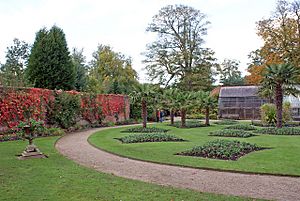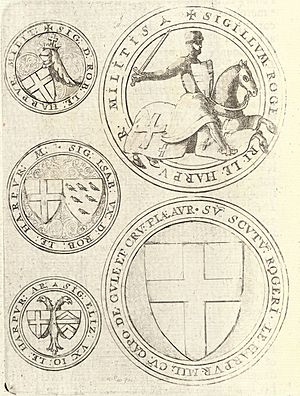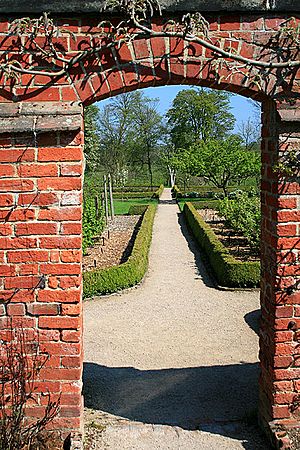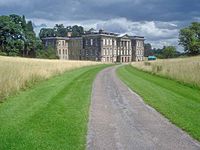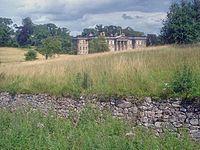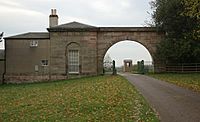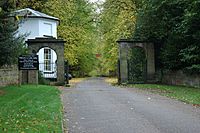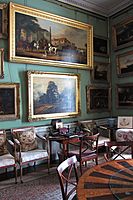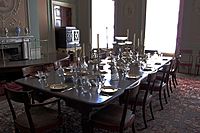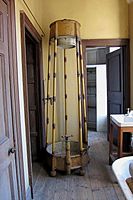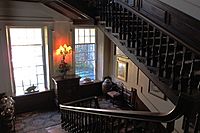Calke Abbey facts for kids
Quick facts for kids Calke Abbey |
|
|---|---|
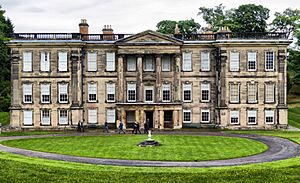
Facade of Calke Abbey (May 2014)
|
|
| General information | |
| Architectural style | Neoclassical, Baroque |
| Location | Ticknall, Derbyshire |
| Country | England, United Kingdom |
| Coordinates | 52°47′59″N 1°27′21″W / 52.79972°N 1.45583°W |
| Construction started | 1701 |
| Completed | 1704 |
| Owner | Harpur Baronets (Harpur and Harpur Crewe Families) National Trust |
|
Listed Building – Grade I
|
|
| Official name: Calke Abbey | |
| Designated: | 2 September 1952 |
| Reference #: | 1031839 |
| Designated: | 4 August 1984 |
| Reference #: | 1000676 |
Calke Abbey is a fascinating country house in Derbyshire, England. It's looked after by the National Trust, a charity that protects historic places. This building is so special that it's a Grade I listed site, meaning it's one of the most important historic buildings in England.
Even though it's called Calke Abbey, it was never actually an abbey! It was once an Augustinian priory (a smaller type of monastery) way back in the 12th century. The grand house you see today is a Baroque mansion built between 1701 and 1704.
The Harpur family owned Calke Abbey for almost 300 years. In 1985, it was given to the National Trust. Today, you can visit the house. Many of its rooms are kept just as they were when the Trust took over, showing how the house looked as it slowly declined over time. It's like a time capsule!
Contents
The Story of Calke Abbey
From Priory to Private Home
Calke Priory was started by Richard d'Avranches, a powerful earl, between 1115 and 1120. It was a religious community dedicated to St Giles. Later, around 1172, the monks moved to a new priory in Repton, and Calke became a smaller, connected site.
During the 14th and 15th centuries, Calke Priory might have been more like a working farm than a religious place.
The Dissolution of Monasteries
In the 1530s, King Henry VIII closed down many monasteries in England. This was called the Dissolution of the Monasteries. Repton Priory, which Calke was part of, was closed in 1536. It was briefly reopened, but then closed for good in 1538.
After Repton Priory closed, the land and buildings of Calke became the property of the Crown (the King).
Calke After the Monasteries Closed
After the priory closed, a man named John Preste moved his family to Calke. He turned the old priory buildings into a Tudor-style house. When he passed away in 1546, he left the lease for Calke to his young daughter, Frances.
Over the next few decades, the ownership of Calke became quite complicated with different families and legal battles. Eventually, in 1585, Robert Bainbridge became the owner. He was a strong Protestant and chose to live at Calke.
In 1622, Robert Bainbridge Jr. sold the estate to Sir Henry Harpur for £5,350. This began the long connection between Calke and the Harpur family.
The Harpur Family at Calke
The Harpur family had become very wealthy and powerful through law and marriage. They owned large estates in different parts of England.
The current house at Calke was rebuilt by Sir John Harpur, the 4th baronet, between 1701 and 1704. It was passed down through generations of the Harpur family.
The last Harpur baronet to own the house was Sir Vauncey Harpur-Crewe. He loved collecting natural history items like birds, butterflies, and fish. When he passed away, some of his collections had to be sold to pay taxes.
Later, in 1981, Charles Harpur-Crewe passed away suddenly. The taxes on his estate were very high. To help pay these taxes, his younger brother, Henry Harpur-Crewe, transferred the entire estate to the National Trust in 1985.
Calke Abbey Today: A House Frozen in Time
The National Trust decided to keep Calke Abbey much as it was when they received it. Many rooms had not been changed since the 1880s. Instead of fully restoring the house, the Trust stopped further damage but left the interiors mostly as they were found. This means visitors can see the house's unique "decay" and get a real sense of its history.
Exploring the Estate and Nature
The land around Calke Abbey is a beautiful landscape park. The National Trust looks after it carefully to protect nature.
Gardens and Green Spaces
- Walled Garden: There's a lovely walled garden with flowers and a kitchen garden where plants for cooking are grown.
- Deer Park: The ancient deer park at Calke Abbey is a special place for nature. It's known for its rare wood pasture habitat, which means it has old trees and deadwood that are home to many insects.
- Veteran Trees: The estate has hundreds of very old trees, including a 1000-year-old oak tree called the Old Man of Calke!
- Historic Park: The entire park and gardens are listed on the National Register of Historic Parks and Gardens, showing their importance.
Outbuildings and History
Next to the main house, there's a large area with old stable buildings and a farmyard. You can see old carriages and farm tools there. There's even an old brewhouse connected to the main house by a tunnel!
The estate also has old limestone quarries near Ticknall. These quarries were once connected by a railway that took limestone to a canal. You can still see one of the old railway tunnels under the drive. The railway closed in 1915.
See also
- Grade I listed buildings in Derbyshire
- Listed buildings in Calke
Gallery
-
The Library


